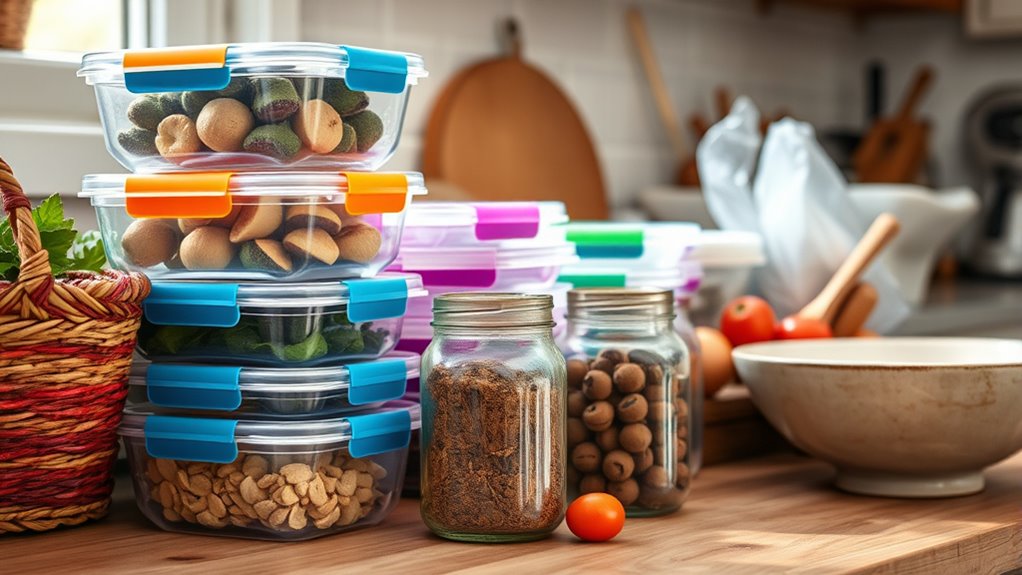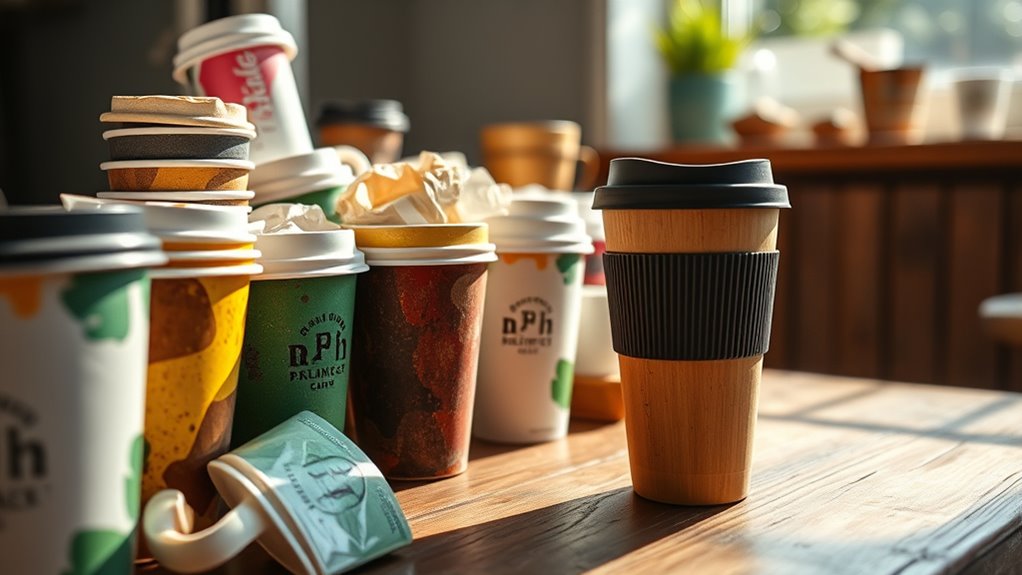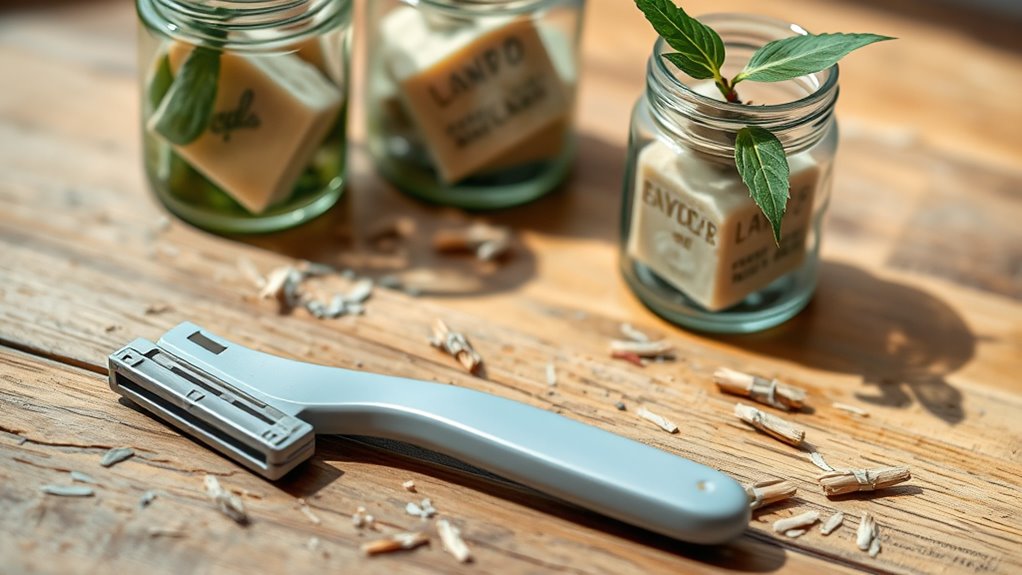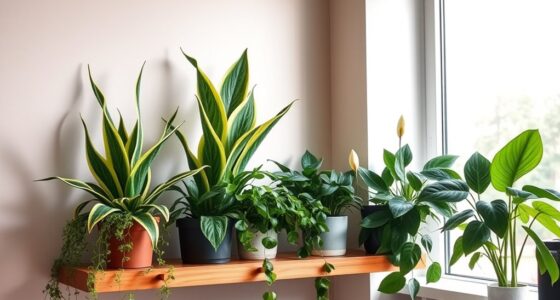You can replace cling film with reusable beeswax wraps or silicone lids. Use glass jars instead of plastic containers for storage. Swap disposable coffee cups for durable, reusable ones, and choose refillable bottles over bottled water. Switch to solid shampoo bars and use upcycled cotton swabs instead of disposable ones. Replace paper towels with cloth rags and opt for eco-friendly, upcycled clothing. Finally, use rechargeable batteries instead of single-use ones. Keep exploring to discover even more sustainable swaps for everyday life.
Key Takeaways
- Replace disposable cling film with reusable beeswax wraps or silicone covers for food storage.
- Swap plastic food containers for durable glass or stainless steel options to reduce waste and chemical exposure.
- Use upcycled glass jars as pantry organizers or DIY storage solutions, extending their usefulness.
- Opt for reusable coffee cups and drinkware made from stainless steel or bamboo, replacing single-use cups.
- Convert old textiles and clothing into reusable bags, rags, or decorative items to minimize textile waste.
Cling Film

Have you ever considered the environmental impact of cling film? This common kitchen essential is non-recyclable and contains harmful chemicals like BPA, contributing to plastic waste. Fortunately, there are eco-friendly alternatives that reduce your plastic footprint. Reusable wraps, such as beeswax wraps, are a great option. Made from natural cotton infused with beeswax, jojoba oil, and tree resin, they’re safe, breathable, and last for months with proper care. Simple reusable cotton covers or silicone lids also work well for covering bowls and leftovers, helping you cut down on single-use plastic. Switching from cling film to these upcycled or homemade alternatives not only minimizes plastic waste but also supports a zero-waste lifestyle. Utilizing biodegradable materials in your homemade wraps can further lessen environmental impact. Incorporating sustainable packaging practices can amplify your eco-friendly efforts and reduce reliance on single-use plastics. Adopting upcycled materials in your kitchen can make your eco-friendly transition even more sustainable. Making this change benefits the environment and keeps your kitchen greener. Additionally, choosing products made from recycled plastics can further support waste reduction initiatives. Using upcycled textiles and reclaimed materials in your DIY projects can enhance sustainability and reduce waste.
Plastic Food Containers

Switching to glass or stainless steel containers means you get durable, safe options that last longer and avoid harmful chemicals. You can also upcycle old plastic containers by cleaning them and using them to organize small items or craft supplies. These simple changes help reduce waste and make your storage more sustainable. Additionally, ensure you wash plastic containers thoroughly to prevent bacterial growth and maintain hygiene. Using containers made from food-safe materials further enhances safety and reduces potential chemical leaching. Incorporating recyclable options into your storage solutions can also contribute to a more eco-friendly lifestyle. Consider choosing upcycled storage solutions that repurpose household items, reducing the need for new plastic products and promoting sustainability. Staying informed about sound vibrations and their health benefits can inspire you to incorporate calming practices into your routine, further supporting a sustainable and mindful lifestyle.
Durable Glass Storage
Looking for a durable and eco-friendly alternative to plastic food containers? Consider using glass jars for storage. They’re long-lasting, can be upcycled into pantry organizers, flower vases, or DIY storage solutions, and help reduce plastic waste. Here are some benefits:
- Glass jars are microwave and dishwasher safe, perfect for leftovers and dry goods.
- They won’t stain, retain odors, or warp over time, keeping their clarity.
- Upcycling glass containers supports a zero-waste lifestyle by minimizing single-use plastics.
- Unlike plastic, they don’t leach chemicals, making them safer for storing food and sauces.
- Incorporating sustainable materials like glass reduces environmental impact and promotes eco-conscious living.
Creative Reuse Ideas
Plastic food containers are versatile for more than just storing leftovers; with some creativity, they can be transformed into practical organizers for your home. You can repurpose plastic containers into DIY projects like storage for craft supplies, hardware, or small household items. Clear plastic containers are perfect for organizing pantry staples like spices, tea bags, or dried herbs, helping you reduce clutter and see everything at a glance. You can also use them as seed starters in gardening—drill drainage holes and fill them with soil to nurture seedlings before transplanting. With a little decoration, they become attractive snack or lunch holders, ideal for kids or picnics, replacing single-use packaging. Combining recycled paper with plastic containers adds a creative touch to your home decor while extending their usefulness. Mindful decluttering can help you assess which containers are truly necessary and prevent unnecessary accumulation, promoting a more organized and sustainable home environment. Additionally, considering professional cleaning services for your home can ensure that your space remains hygienic and well-maintained, especially when repurposing items for food storage. Exploring upcycling techniques can open new possibilities for transforming everyday items into functional decor or gifts. Incorporating sustainable practices into your routine further enhances your efforts to reduce waste and support environmental health.
Disposable Coffee Cups

Switching to reusable coffee cups made from ceramic or stainless steel can drastically cut down on waste. Unlike disposable cups, these durable options last for years and don’t contain plastic linings that can’t be recycled. Plus, many coffee shops offer discounts when you bring your own, making it both eco-friendly and cost-effective. Using reusable drinkware for beverages can significantly reduce environmental impact. Using electric bikes for commuting can also reduce your carbon footprint. Additionally, choosing sustainable materials for everyday items supports eco-friendly manufacturing practices. Incorporating upcycled products into your daily routine can further minimize waste and promote sustainability.
Reusable Coffee Cups
Reusable coffee cups made from materials like stainless steel or bamboo offer a practical and eco-friendly alternative to disposable cups, which are discarded in the billions each day worldwide. By choosing reusable cups, you help reduce the staggering 500 billion single-use coffee cups ending up in landfills annually. Many coffee shops, including Starbucks and Costa, encourage eco-friendly habits by offering discounts for bringing your own reusable cup. Unlike disposable cups, which often contain plastic lining that’s hard to recycle, reusable cups eliminate this issue altogether. Additionally, using reusable cups supports the use of sustainable materials and eco-conscious habits, further decreasing environmental impact.
Ceramic or Stainless Steel
Choosing ceramic or stainless steel coffee cups for your daily routine offers a sustainable alternative to single-use disposables. These reusable options are designed to last for years, drastically reducing waste compared to disposable cups that are used just once. Ceramic mugs are microwave and dishwasher safe, making them convenient and easy to clean daily. Stainless steel travel mugs often feature insulation, keeping beverages hot or cold for up to 12 hours, unlike disposable cups that lose temperature quickly. Most disposable coffee cups are lined with plastic or polyethylene, which complicates recycling, while ceramic and stainless steel options are fully recyclable or reusable. By choosing an eco-friendly, upcycled coffee cup, you help prevent billions of single-use cups from polluting landfills and reduce your environmental impact.
Bottled Water

Bottled water contributes considerably to environmental waste, but you can make a difference by opting for sustainable alternatives. Using reusable bottles helps cut down on plastic waste and reduces chemical leaching from single-use bottles. Here are some eco-friendly choices to contemplate:
- Switch to stainless steel or BPA-free plastic bottles for daily hydration.
- Use glass bottles with silicone sleeves for a durable, chemical-free option.
- Invest in large refillable water containers to minimize disposable bottles.
- Opt for collapsible bottles made from silicone, perfect for travel and outdoor activities.
Shampoo Bottles

Switching from plastic shampoo bottles to solid shampoo bars is one of the most effective ways to cut down on plastic waste. Plastic bottles often end up in landfills or oceans, but solid shampoo bars eliminate the need for plastic packaging altogether. Many eco-friendly options come in compostable or recyclable packaging, making them a sustainable choice. These bars last longer—up to 80 washes—reducing overall product consumption. To further minimize waste, you can use refillable containers, like glass or aluminum, for homemade or bulk shampoos. Choosing solid shampoo bars not only helps you reduce waste but also avoids the harmful chemicals found in many plastic bottles. It’s a simple, impactful switch toward an eco-friendlier hair care routine.
Disposable Razors

Disposable razors generate a huge amount of plastic waste each year, but switching to reusable safety razors can make a difference. Metal blades are recyclable and last longer, cutting down on waste and costs. Plus, you can repurpose old razor handles into creative upcycled crafts, giving them a new life.
Reusable Safety Razors
Reusable safety razors offer a sustainable alternative to single-use disposable razors by featuring a durable metal handle and replaceable blades. By making the switch, you profoundly reduce plastic waste and support an eco-friendly lifestyle. With proper maintenance, your safety razor can last for years, cutting down on landfill waste. Additionally, replacing blades is more economical over time, saving you money. Here are some benefits:
- Reduces plastic waste by avoiding disposable plastic cartridges.
- Eliminates non-recyclable cartridge packaging.
- Supports a zero-waste approach in your grooming routine.
- Offers long-term, cost-effective use compared to disposable razors.
Choosing a reusable safety razor not only benefits the environment but also promotes mindful, sustainable grooming habits. It’s a simple switch that makes a big impact on reducing plastic pollution and living more eco-friendly.
Eco-Friendly Replacement Blades
Eco-friendly replacement blades for safety razors are designed to minimize environmental impact while maintaining effective grooming. These recyclable metal blades can be replaced individually, reducing plastic waste and making them a sustainable choice. Unlike disposable razors, which are discarded after a few uses, replaceable blades last for months, cutting down on waste and saving you money over time. Many brands now offer biodegradable or recyclable packaging for these blades, further supporting eco-friendly habits. By switching to safety razors with replaceable blades, you can reduce plastic waste by up to 95%. Though the initial cost is higher, the long-term benefits include less landfill clutter and a smaller carbon footprint. It’s a simple upgrade that makes a significant environmental difference.
Upcycled Razor Handle Crafts
Have you considered transforming your used razor handles into practical and creative crafts? Recycling upcycled razor handles not only reduces plastic waste but also sparks your DIY creativity. Here are some ideas to get you started:
- Convert handles into small tools like paint scrapers or cleaning brushes with minor modifications.
- Drill holes and turn them into jewelry pieces or keychains, adding decorative elements for a personalized touch.
- Use the sturdy handles as bases for mini plant markers or garden labels.
- Repurpose the handles into unique gift tags or ornaments for special occasions.
Upcycling these everyday items promotes sustainable habits and markedly decreases the amount of plastic ending up in landfills, helping you make an eco-friendly impact through simple crafts.
Cotton Swabs

Are traditional plastic-stemmed cotton swabs really the only option for ear cleaning? Not anymore. You can choose eco-friendly alternatives like biodegradable cotton swabs made from bamboo or paper sticks, which decompose faster and reduce plastic pollution. Reusable options, such as silicone or metal ear cleaning tools, eliminate waste and save money over time. If you’re into DIY projects, you can craft reusable cotton swabs by attaching small pieces of cloth or felt to chopsticks or paper clips for gentle cleaning. Many eco-friendly brands now offer cotton swabs with compostable or recycled paper stems, providing sustainable, convenient options. Switching to these natural alternatives helps prevent microfibers from polluting waterways and protects aquatic life, making your ear cleaning routine more environmentally responsible.
Paper Towels

Did you know switching from paper towels to reusable cloths can substantially reduce household waste? By making this switch, you cut down on the amount of waste sent to landfills and lessen the environmental impact. Here are four reasons to contemplate this change:
- Reusable cloth rags or microfiber towels can cut household waste by up to 75%.
- Cotton or bamboo dishcloths are durable, absorbent, and save money over time.
- Using cloth reduces the water and energy used in paper towel production, helping the environment.
- Cloths are easy to sanitize in hot water or the washing machine, maintaining hygiene without single-use disposables.
Switching to cloth alternatives is a simple, eco-friendly way to help protect our environment while saving money.
Synthetic Clothing

Synthetic clothing made from fibers like polyester, nylon, and acrylic is a major contributor to environmental pollution because these materials are non-biodegradable and release microplastics when washed. To reduce this impact, consider upcycling natural textiles such as linen, hemp, or organic cotton into new garments, which are better clothing alternatives. By choosing upcycled or vintage items, you extend their lifespan and cut down on the demand for new clothing production, helping decrease textile waste. DIY modifications, like turning an old T-shirt into a reusable shopping bag or patching tears, promote sustainable fashion practices. Supporting upcycling not only minimizes the environmental impact of synthetic fibers but also encourages a circular fashion economy that reuses materials and reduces waste, making your wardrobe more eco-friendly.
Single-Use Batteries

Have you ever considered how frequently you toss out single-use batteries? Switching to rechargeable batteries is a simple way to reduce waste and protect the environment. Here’s why:
- Rechargeable batteries like NiMH and lithium-ion can be used hundreds of times, cutting down on hazardous waste.
- Disposing of single-use batteries releases toxic chemicals like mercury and lead, which can harm the environment.
- Upgrading to eco-friendly, rechargeable options saves you money over time since they last much longer.
- Recycling and proper disposal of batteries is important, but preventing waste by choosing rechargeable batteries is even better.
Frequently Asked Questions
What Are the Best Items to Upcycle?
When it comes to upcycling, you’ll find that common household items are perfect candidates. Glass jars and bottles are great for storage or decoration, while old clothing can become tote bags or cleaning rags. Cardboard boxes and cereal cartons are versatile for organizing or craft projects. Plastic containers work well for seed starters or art supplies. Stale bread can be turned into croutons or breadcrumbs, helping you reduce waste creatively.
How Do You Upcycle Everyday Items?
Did you know that upcycling reduces waste by 30%? To upcycle everyday items, start by gathering things like jars, bottles, or boxes. Clean and prep them with simple tools such as scissors, glue, or paint. Get creative—turn jars into planters or candle holders. Follow step-by-step tutorials, add personal touches, and document your progress. You’ll save money, help the environment, and create stylish, functional pieces from items you’d otherwise toss away.
What Are Upcycled Materials?
Upcycled materials are items you creatively repurpose or transform into new, functional, or decorative objects while keeping their original form. You actively give these items a second life by modifying them, which adds value and reduces waste. Instead of recycling, you preserve the item’s shape and style, making eco-friendly choices. Using upcycled materials helps you cut down on waste, save money, and make your home more sustainable through creative DIY projects.
What Is the Difference Between Upcycling and Repurposing?
You might wonder, what’s the real difference between upcycling and repurposing? Upcycling transforms an item into something of higher quality, value, or aesthetic appeal, making it more useful or attractive. Repurposing, on the other hand, simply gives an item a new purpose without changing its value or appearance. It’s about extending usefulness, while upcycling aims to enhance both function and beauty—both creative ways to reduce waste and add personality.
Conclusion
By swapping out everyday items for upcycled alternatives, you not only reduce waste but also make a positive impact on the planet. It’s true what they say—waste not, want not. Small changes in your daily routine can add up to big environmental benefits. So, give these upcycled ideas a try and remember, every little bit helps in creating a more sustainable world. Your choices matter more than you think.









